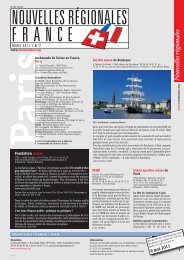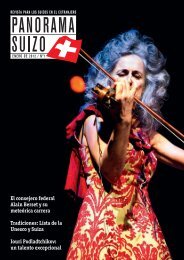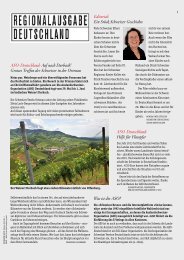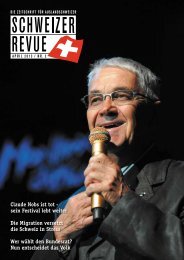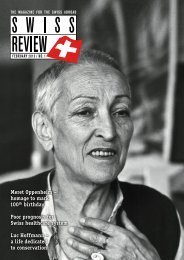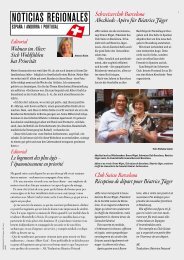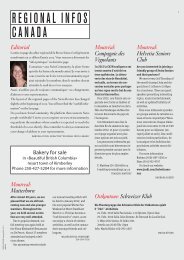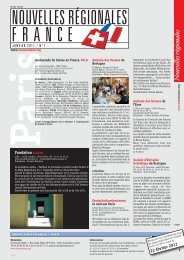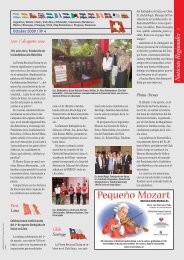Download PDF Swiss Review 3/2013 High ... - Schweizer Revue
Download PDF Swiss Review 3/2013 High ... - Schweizer Revue
Download PDF Swiss Review 3/2013 High ... - Schweizer Revue
Create successful ePaper yourself
Turn your PDF publications into a flip-book with our unique Google optimized e-Paper software.
16 Literature<br />
Between two worlds: books and literary figures among the <strong>Swiss</strong> abroad<br />
By Charles Linsmayer<br />
Born in Ticino, she wrote love poetry in Argentina<br />
that is still causing a stir 100 years on – Alfonsina Storni<br />
<strong>Swiss</strong> <strong>Review</strong> June <strong>2013</strong> / No. 3<br />
Photo: donated<br />
The Chilean Nobel Prize winner Gabriela Mistral called her Argentinean<br />
peer Alfonsina Storni a “bee-wasp who danced a frantic swirl<br />
around her own body before bleeding to death in a seemingly playful<br />
pirouette”. She was describing not just the difficult life but also<br />
the solitary death of this extraordinary woman who was born in the<br />
village of Sala Capriasca in Ticino in 1892 and was regarded as one<br />
of Latin America’s great poets by the time of her death in 1938.<br />
“The frantic swirl which she danced around her own body” refers<br />
to the circumstances in which Alfonsina Storni’s poetry was produced.<br />
She arrived in Argentina in<br />
1896, aged four, with her father who<br />
went on a downward spiral – from being<br />
a brewer he ended up the drunken<br />
landlord of the “Café Suizo” in San<br />
Juan, which soon went to the wall – and<br />
with her mother who provided the necessities<br />
as a seamstress and teacher. At<br />
the age of 13 she was working in a hat<br />
factory, and at 15 she went on tour with<br />
a theatre company. In 1909, aged 17,<br />
she entered the teacher training college<br />
in Coronda, from which she was<br />
almost expelled when it became known<br />
in which establishments she was earning<br />
her tuition fees as a dancer! She<br />
had begun writing poetry at the age of<br />
12 – much to the annoyance of her<br />
mother, who clipped her around the<br />
ear for it – and did not relinquish her<br />
passion even after a bad experience of<br />
love. In 1911, the 19-year-old, now a<br />
teacher in Rosario, was having a secret<br />
affair with a well-known politician and<br />
fled to the anonymity of Buenos Aires<br />
to avoid scandal when she became<br />
pregnant. She gave birth to the “love<br />
child” in this city, where she also<br />
worked as a saleswoman and later as a<br />
secretary. In 1916, she published her<br />
first work “La inquietud del rosal” at<br />
her own expense. “May God protect<br />
you from the impatience of the rose<br />
Quotation<br />
“It is midnight. The city separates me from<br />
you – a crowded black mass, rows of houses,<br />
forests of lost yet lingering words, invisible<br />
clouds of microscopically small bodies. But I<br />
unfold my soul beyond myself, I reach you, I<br />
touch you. You are awake, you quiver when<br />
you hear me. My soul is so close to you, how it<br />
quivers together with you.”<br />
(From “Poemas de amor”, Buenos Aires 1926)<br />
BibliographY: Alfonsina Storni’s “Poemas de<br />
amor” are available from Limmat-Verlag, Zurich<br />
in German and Spanish, translated into German<br />
by Reinhard Streit. Available in Italian and Spanish<br />
from Casagrande, Bellinzona, translated into<br />
Italian by Augusta López-Bernasocchi.<br />
bush,” she declared to friends, “but I wrote to stay alive”. In 1925,<br />
in her remorselessly audacious work “Ocre”, she declared to her unfaithful<br />
lover: “It is not you who betrays me. It is my dreams alone.”<br />
She had long been famous when she visited her birthplace in Ticino<br />
for the last time in 1930. García Lorca also admired her and described<br />
her forsaken dreams in the lines: “Oh you beast, you perfidious<br />
soul, have you hidden yourself away and built a nest in your<br />
longings.” These forsaken dreams are there for all to see in the “Poemas<br />
de amor”, published in 1926, in which she again evokes the love<br />
affair of 1911 but now completely withdraws<br />
into the dream where the lover is<br />
only tangible as a “fantasma aeriforme”,<br />
an “illusion of air”. Death was a major<br />
theme not just here but in her entire<br />
opus. In “Ocre”, she mockingly contrives<br />
an epitaph for her grave: “The<br />
woman who sleeps beneath the earth/<br />
and ridicules life with the epitaph on her<br />
grave,/ wrote, because she was a woman,<br />
on her grave/ another lie – I have had<br />
enough.”<br />
But what about the “playful pirouette”<br />
from which she bled to death, according<br />
to Gabriela Mistral? “No puedo<br />
más” (“I can’t take any more”),<br />
wrote Alfonsina Storni on a sheet of paper<br />
in a hotel room in Mar del Plata before,<br />
suffering from terminal cancer,<br />
she sought her death in the sea on 25 October<br />
1938. Her final poem “Voy a dormer”<br />
(“I am going to sleep”) appeared<br />
in the “La Nación” newspaper on the<br />
day of her death. The verses sing the<br />
praises of death like a lullaby but contain<br />
a hint of sarcasm as though they are<br />
rebuffing a final lover: “One more<br />
thing:/ if he calls again,/ tell him his efforts<br />
are in vain because I’ve gone.”<br />
CHARLES LINSMAYER is a literary scholar<br />
and journalist in Zurich



